小编给大家分享一下Node如何搭建一个静态资源服务器,相信大部分人都还不怎么了解,因此分享这篇文章给大家参考一下,希望大家阅读完这篇文章后大有收获,下面让我们一起去了解一下吧!
使用 Node 的内置模块,创建一个可以访问目录的静态资源服务器,支持fs文件读取,资源压缩与缓存等。
一、创建 HTTP Server 服务器
Node 的 http 模块提供 HTTP 服务器和客户端接口,通过 require('http') 使用。
先创建一个简单的 http server。配置参数如下:
// server/config.js module.exports = { root: process.cwd(), host: '127.0.0.1', port: '8877' }process.cwd()方法返回 Node.js 进程的当前工作目录,和 Linus 命令 pwd 功能一样,
Node 服务器每次收到 HTTP 请求后都会调用 http.createServer() 这个回调函数,每次收一条请求,都会先解析请求头作为新的 request 的一部分,然后用新的 request 和 respond 对象触发回调函数。以下创建一个简单的 http 服务,先默认响应的 status 为 200:
// server/http.js const http = require('http') const path = require('path') const config = require('./config') const server = http.createServer((request, response) => { let filePath = path.join(config.root, request.url) response.statusCode = 200 response.setHeader('content-type', 'text/html') response.write(`<html><body><h2>Hello World! </h2><p>${filePath}</p></body></html>`) response.end() }) server.listen(config.port, config.host, () => { const addr = `http://${config.host}:${config.port}` console.info(`server started at ${addr}`) })客户端请求静态资源的地址可以通过 request.url 获得,然后使用 path 模块拼接资源的路径。
执行 $ node server/http.js 后访问 http://127.0.0.1 :8877/ 后的任意地址都会显示该路径:
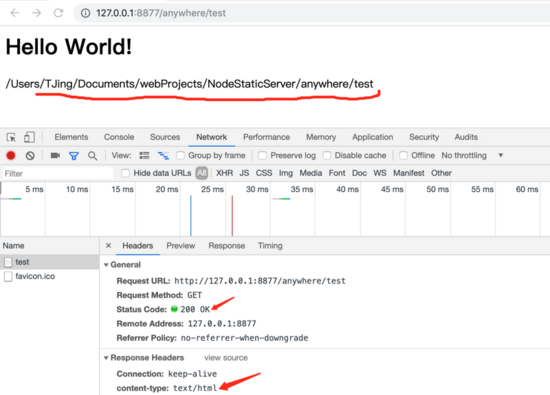
每次修改服务器响应内容,都需要重新启动服务器更新,推荐自动监视更新自动重启的插件supervisor,使用supervisor启动服务器。
$ npm install supervisor -D $ supervisor server/http.js
二、使用 fs 读取资源文件
我们的目的是搭建一个静态资源服务器,当访问一个到资源文件或目录时,我们希望可以得到它。这时就需要使用 Node 内置的 fs 模块读取静态资源文件,
使用 fs.stat() 读取文件状态信息,通过回调中的状态 stats.isFile() 判断文件还是目录,并使用 fs.readdir() 读取目录中的文件名
// server/route.js const fs = require('fs') module.exports = function (request, response, filePath){ fs.stat(filePath, (err, stats) => { if (err) { response.statusCode = 404 response.setHeader('content-type', 'text/plain') response.end(`${filePath} is not a file`) return; } if (stats.isFile()) { response.statusCode = 200 response.setHeader('content-type', 'text/plain') fs.createReadStream(filePath).pipe(response) } else if (stats.isDirectory()) { fs.readdir(filePath, (err, files) => { response.statusCode = 200 response.setHeader('content-type', 'text/plain') response.end(files.join(',')) }) } }) }其中 fs.createReadStream() 读取文件流, pipe() 是分段读取文件到内存,优化高并发的情况。
修改之前的 http server ,引入上面新建的 route.js 作为响应函数:
// server/http.js const http = require('http') const path = require('path') const config = require('./config') const route = require('./route') const server = http.createServer((request, response) => { let filePath = path.join(config.root, request.url) route(request, response, filePath) }) server.listen(config.port, config.host, () => { const addr = `http://${config.host}:${config.port}` console.info(`server started at ${addr}`) })再次执行 $ node server/http.js 如果是文件夹则显示目录:

如果是文件则直接输出:

成熟的静态资源服务器 anywhere,深入理解 nodejs 作者写的。
三、util.promisify 优化 fs 异步
我们注意到 fs.stat() 和 fs.readdir() 都有 callback 回调。我们结合 Node 的 util.promisify() 来链式操作,代替地狱回调。
util.promisify 只是返回一个 Promise 实例来方便异步操作,并且可以和 async/await 配合使用,修改 route.js 中 fs 操作相关的代码:
// server/route.js const fs = require('fs') const util = require('util') const stat = util.promisify(fs.stat) const readdir = util.promisify(fs.readdir) module.exports = async function (request, response, filePath) { try { const stats = await stat(filePath) if (stats.isFile()) { response.statusCode = 200 response.setHeader('content-type', 'text/plain') fs.createReadStream(filePath).pipe(response) } else if (stats.isDirectory()) { const files = await readdir(filePath) response.statusCode = 200 response.setHeader('content-type', 'text/plain') response.end(files.join(',')) } } catch (err) { console.error(err) response.statusCode = 404 response.setHeader('content-type', 'text/plain') response.end(`${filePath} is not a file`) } }因为 fs.stat() 和 fs.readdir() 都可能返回 error,所以使用 try-catch 捕获。
使用异步时需注意,异步回调需要使用 await 返回异步操作,不加 await 返回的是一个 promise,而且 await 必须在async里面使用。
四、添加模版引擎
从上面的例子是手工输入文件路径,然后返回资源文件。现在优化这个例子,将文件目录变成 html 的 a 链接,点击后返回文件资源。
在第一个例子中使用 response.write() 插入 HTML 标签,这种方式显然是不友好的。这时候就使用模版引擎做到拼接 HTML。
常用的模版引擎有很多,ejs、jade、handlebars,这里的使用ejs:
npm i ejs
新建一个模版 src/template/index.ejs ,和 html 文件很像:
<!DOCTYPE html> <html lang="en"> <head> <meta charset="UTF-8"> <title>Node Server</title> </head> <body> <% files.forEach(function(name){ %> <a href="../<%= dir %>/<%= name %>" rel="external nofollow" > <%= name %></a><br> <% }) %> </body> </html>再次修改 route.js,添加 ejs 模版并 ejs.render() ,在文件目录的代码中传递 files、dir 等参数:
// server/route.js const fs = require('fs') const util = require('util') const path = require('path') const ejs = require('ejs') const config = require('./config') // 异步优化 const stat = util.promisify(fs.stat) const readdir = util.promisify(fs.readdir) // 引入模版 const tplPath = path.join(__dirname,'../src/template/index.ejs') const sourse = fs.readFileSync(tplPath) // 读出来的是buffer module.exports = async function (request, response, filePath) { try { const stats = await stat(filePath) if (stats.isFile()) { response.statusCode = 200 ··· } else if (stats.isDirectory()) { const files = await readdir(filePath) response.statusCode = 200 response.setHeader('content-type', 'text/html') // response.end(files.join(',')) const dir = path.relative(config.root, filePath) // 相对于根目录 const data = { files, dir: dir ? `${dir}` : '' // path.relative可能返回空字符串() } const template = ejs.render(sourse.toString(),data) response.end(template) } } catch (err) { response.statusCode = 404 ··· } }重启动 $ node server/http.js 就可以看到文件目录的链接:
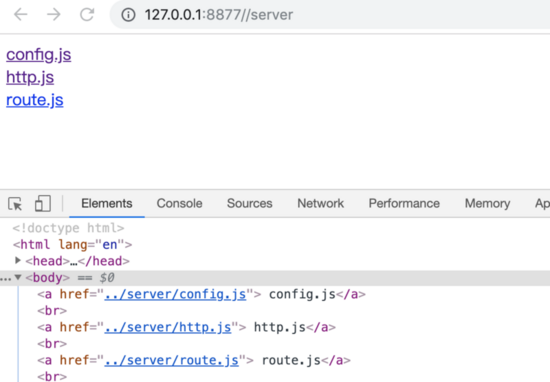
五、匹配文件 MIME 类型
静态资源有图片、css、js、json、html等,
在上面判断 stats.isFile() 后响应头设置的 Content-Type 都为 text/plain,但各种文件有不同的 Mime 类型列表。
我们先根据文件的后缀匹配它的 MIME 类型:
// server/mime.js const path = require('path') const mimeTypes = { 'js': 'application/x-javascript', 'html': 'text/html', 'css': 'text/css', 'txt': "text/plain" } module.exports = (filePath) => { let ext = path.extname(filePath) .split('.').pop().toLowerCase() // 取扩展名 if (!ext) { // 如果没有扩展名,例如是文件 ext = filePath } return mimeTypes[ext] || mimeTypes['txt'] }匹配到文件的 MIME 类型,再使用 response.setHeader('Content-Type', 'XXX') 设置响应头:
// server/route.js const mime = require('./mime') ··· if (stats.isFile()) { const mimeType = mime(filePath) response.statusCode = 200 response.setHeader('Content-Type', mimeType) fs.createReadStream(filePath).pipe(response) }运行 server 服务器访问一个文件,可以看到 Content-Type 修改了:
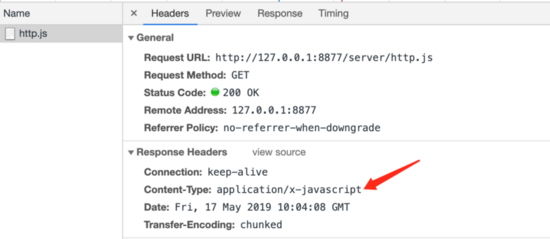
六、文件传输压缩
注意到 request header 中有 Accept—Encoding:gzip,deflate,告诉服务器客户端所支持的压缩方式,响应时 response header 中使用 content-Encoding 标志文件的压缩方式。
node 内置 zlib 模块支持文件压缩。在前面文件读取使用的是 fs.createReadStream() ,所以压缩是对 ReadStream 文件流。示例 gzip,deflate 方式的压缩:
最常用文件压缩,gzip等,使用,对于文件是用ReadStream文件流进行读取的,所以对ReadStream进行压缩:
// server/compress.js const zlib = require('zlib') module.exports = (readStream, request, response) => { const acceptEncoding = request.headers['accept-encoding'] if (!acceptEncoding || !acceptEncoding.match(/\b(gzip|deflate)\b/)) { return readStream } else if (acceptEncoding.match(/\bgzip\b/)) { response.setHeader("Content-Encoding", 'gzip') return readStream.pipe(zlib.createGzip()) } else if (acceptEncoding.match(/\bdeflate\b/)) { response.setHeader("Content-Encoding", 'deflate') return readStream.pipe(zlib.createDeflate()) } }修改 route.js 文件读取的代码:
// server/route.js const compress = require('./compress') ··· if (stats.isFile()) { const mimeType = mime(filePath) response.statusCode = 200 response.setHeader('Content-Type', mimeType) // fs.createReadStream(filePath).pipe(response) + let readStream = fs.createReadStream(filePath) + if(filePath.match(config.compress)) { // 正则匹配:/\.(html|js|css|md)/ readStream = compress(readStream,request, response) } readStream.pipe(response) }运行 server 可以看到不仅 response header 增加压缩标志,而且 3K 大小的资源压缩到了 1K,效果明显:
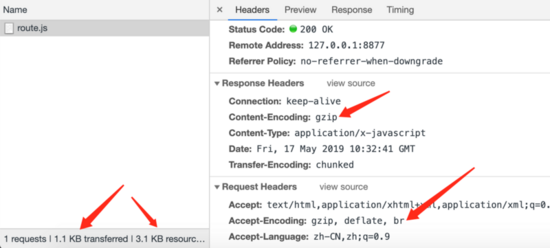
七、资源缓存
以上的 Node 服务都是浏览器首次请求或无缓存状态下的,那如果浏览器/客户端请求过资源,一个重要的前端优化点就是缓存资源在客户端。 缓存有强缓存和协商缓存 :
强缓存在 Request Header 中的字段是 Expires 和 Cache-Control;如果在有效期内则直接加载缓存资源,状态码直接是显示 200。
协商缓存在 Request Header 中的字段是:
If-Modified-Since(对应值为上次 Respond Header 中的 Last-Modified)
If-None—Match(对应值为上次 Respond Header 中的 Etag)
如果协商成功则返回 304 状态码,更新过期时间并加载浏览器本地资源,否则返回服务器端资源文件。
首先配置默认的 cache 字段:
// server/config.js module.exports = { root: process.cwd(), host: '127.0.0.1', port: '8877', compress: /\.(html|js|css|md)/, cache: { maxAge: 2, expires: true, cacheControl: true, lastModified: true, etag: true } }新建 server/cache.js,设置响应头:
const config = require('./config') function refreshRes (stats, response) { const {maxAge, expires, cacheControl, lastModified, etag} = config.cache; if (expires) { response.setHeader('Expires', (new Date(Date.now() + maxAge * 1000)).toUTCString()); } if (cacheControl) { response.setHeader('Cache-Control', `public, max-age=${maxAge}`); } if (lastModified) { response.setHeader('Last-Modified', stats.mtime.toUTCString()); } if (etag) { response.setHeader('ETag', `${stats.size}-${stats.mtime.toUTCString()}`); // mtime 需要转成字符串,否则在 windows 环境下会报错 } } module.exports = function isFresh (stats, request, response) { refreshRes(stats, response); const lastModified = request.headers['if-modified-since']; const etag = request.headers['if-none-match']; if (!lastModified && !etag) { return false; } if (lastModified && lastModified !== response.getHeader('Last-Modified')) { return false; } if (etag && etag !== response.getHeader('ETag')) { return false; } return true; };最后修改 route.js 中的
// server/route.js + const isCache = require('./cache') if (stats.isFile()) { const mimeType = mime(filePath) response.setHeader('Content-Type', mimeType) + if (isCache(stats, request, response)) { response.statusCode = 304; response.end(); return; } response.statusCode = 200 // fs.createReadStream(filePath).pipe(response) let readStream = fs.createReadStream(filePath) if(filePath.match(config.compress)) { readStream = compress(readStream,request, response) } readStream.pipe(response) }重启 node server 访问某个文件,在第一次请求成功时 Respond Header 返回缓存时间:
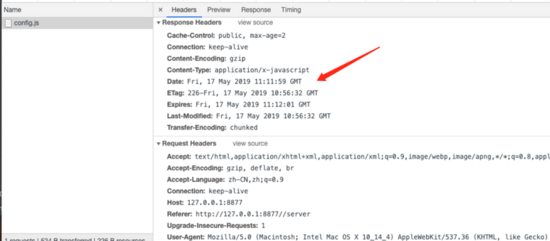
一段时间后再次请求该资源文件,Request Header 发送协商请求字段:
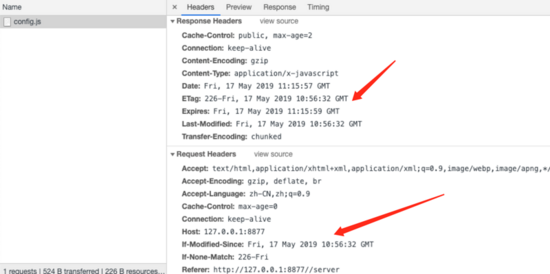
以上是“Node如何搭建一个静态资源服务器”这篇文章的所有内容,感谢各位的阅读!相信大家都有了一定的了解,希望分享的内容对大家有所帮助,如果还想学习更多知识,欢迎关注亿速云行业资讯频道!
免责声明:本站发布的内容(图片、视频和文字)以原创、转载和分享为主,文章观点不代表本网站立场,如果涉及侵权请联系站长邮箱:is@yisu.com进行举报,并提供相关证据,一经查实,将立刻删除涉嫌侵权内容。